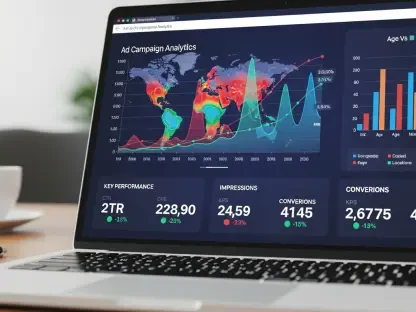Setting the Stage for a Marketing Transformation
In an era where consumer behavior shifts faster than ever, the marketing industry faces a critical challenge: how to keep pace with real-time demands while delivering impactful results. A staggering statistic reveals that brands losing just 24 hours on campaign deployment can miss out on up to 30% of potential engagement opportunities, underscoring the urgent need for a radical rethink of traditional marketing structures. Enter Positionless Agility, a groundbreaking approach that empowers individual marketers to own every facet of a campaign lifecycle—from data insights to creative output and performance tweaks. This analysis dives deep into the market dynamics driving this shift, examining current trends, dissecting data-backed outcomes, and projecting the future trajectory of this transformative model in the marketing landscape.
Unpacking Market Dynamics and Trends
The Shift from Rigid Hierarchies to Fluid Execution
The marketing sector has witnessed a seismic shift over recent years, moving away from siloed, hierarchical models toward more integrated and responsive frameworks. Traditional setups, with separate teams for analytics, creative, and media, often result in delayed responses to market changes, costing brands critical opportunities. Positionless Agility addresses this by enabling a single marketer to manage end-to-end processes, drastically cutting down decision-making timelines. Data from leading consumer brands shows that adopting such agile models has led to campaign launch times shrinking from days to mere hours, highlighting a clear market trend favoring speed and adaptability over outdated compartmentalization.
Technology as a Market Catalyst
A pivotal force reshaping the marketing arena is the rapid integration of advanced technologies like data analytics platforms and generative AI. These tools equip marketers with instant access to audience insights and automate content creation, fundamentally altering execution speeds. For instance, some entertainment brands have reduced campaign development cycles from five days to under an hour by leveraging automation. Market analysis indicates that companies investing in these technologies are gaining a competitive edge, though the risk of over-reliance on tech without human oversight persists as a notable concern. This trend points to a growing reliance on digital infrastructure as a cornerstone of marketing agility.
Ownership Redefining Accountability Standards
Another significant trend is the emphasis on individual ownership within marketing teams. By consolidating responsibility under one marketer for the full campaign journey, Positionless Agility minimizes errors stemming from miscommunication across departments. Market observations reveal that in digitally mature regions like North America, this approach has driven higher campaign success rates, with some firms reporting up to an 18% improvement in customer retention metrics over short timeframes. However, disparities in tech adoption across global markets suggest uneven implementation, with less advanced regions facing skill gaps that could slow adoption. This shift toward accountability is reshaping how performance is measured and attributed in the industry.
Data Insights and Future Projections
Current Performance Metrics Signaling Success
Delving into hard data, the impact of Positionless Agility on marketing outcomes is undeniable. Consumer brands adopting this model have reported a remarkable 16.1x increase in purchase rates by enabling rapid, data-driven campaign adjustments. Efficiency gains are equally compelling, with certain firms condensing multi-team workflows into single-day tasks without expanding headcount. These metrics underscore a market reality where agility translates directly into measurable revenue growth and customer engagement, setting a benchmark for others to follow in a hyper-competitive environment.
Emerging Trends Shaping the Horizon
Looking ahead, several market indicators suggest that Positionless Agility will only deepen its foothold. The continued evolution of AI and machine learning is expected to enhance predictive analytics, allowing for even more precise targeting and personalization between 2025 and 2027. Economic pressures are likely to push organizations toward leaner structures, favoring individual-driven models over expansive teams. Additionally, evolving data privacy regulations may introduce complexities in rapid execution but are also spurring innovation in compliant tech solutions. These trends collectively signal a market poised for a structural overhaul, prioritizing adaptability above all.
Long-Term Industry Transformation
Projecting further, industry forecasts anticipate that within the next decade, Positionless Agility could become the standard operating model for marketing departments globally. The vision is one of dynamic, project-based roles replacing fixed positions, allowing teams to pivot instantly based on market needs. This transformation will likely demand a workforce of multi-skilled strategists capable of navigating data, creative, and optimization domains with ease. As this model matures, it could redefine not just marketing but broader organizational cultures, embedding flexibility as a core competitive trait across industries.
Reflecting on Insights and Strategic Pathways
Looking back, the analysis of Positionless Agility reveals a marketing landscape in the midst of profound change, driven by the urgent need for speed, the power of technology, and the clarity of individual ownership. The data paints a compelling picture of success for early adopters, while emerging trends point to an inevitable industry-wide shift. For businesses, the strategic path forward involves investing in cutting-edge tools and upskilling teams to operate with autonomy and precision. Marketers are encouraged to embrace cross-functional expertise, piloting agile campaigns to test and scale impact. Ultimately, the journey ahead hinges on breaking free from legacy constraints, adopting dynamic experimentation, and building systems that codify rapid wins into lasting market dominance.









